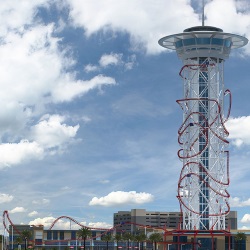It's not just construction costs, but also the space required. A lot of theme parks don't have the land available for a huge scale roller coaster. But even when they do, they have to factor the costs into their profit margins. So theme parks typically work 3 years in advance, so a new ride will be planned, then money made available for it, then time to plan it all out and build it.
Take Fury 325, for example. Its a huge ride, B&M's second giga coaster. It cost $30,000,000 (30 million USD), and required an extension of the theme park along with a remapping of the park entrance, car park, and roads.

If it's inversions you want, then take the Smiler. It has 14 inversions, but ends up being a complete mess of a ride. Us human can only take so much, and nausea starts setting in after too many inversions. An inversion subjects the human body to strong positive G forces (3.5 - 4.0 G's), then almost no G force (down to 0.8 G's typically), then back to high G's again, all in a short space of time. Our internal organs go from normal, to 4 times their weight, then almost weightless, then back to 4 times their weight again, then back to normal. After 14 times in a row, this can be a bit much. To factor this in, the ride layout has to have pace-breaks (moments of calm). The Smiler splits the ride into two, with a complete stop and second lift in the middle of the ride, this helps to spread it out a bit.

If height is your thing, then there is Top Thrill Dragster and Kingda Ka, both around 420 ft tall (128m), which is the average height of a New York or London sky scraper. Speaking of sky scrapers, there is a new type of coaster bound for Orlando known as a poler coaster. This will be 570ft tall.
As for speed, then Top Thrill Dragster and Kingda Ka both go around 128mph (206 kph) , but the ride time is only around 50 seconds because of it. The trouble with high speed is you cover a lot of distance in a short period of time, so the rides are equally huge. Formula Rossa holds the world record right now at 149mph (240 kph). It doesn't help that its built in a desert, as riders have to wear goggles to ride it in case anything goes in their eyes at that speed. The trains take a beating too, and the wheel are sprayed with water to accommodate the heat - not just from the track, but also the speed.
So to answer your question, yes its because of money. But also land space, limitations of the human body, planning and engineering, limitations of engineering (stress on track and trains) which can make an investment worthless if it costs more to maintain and run than profit that it generates (see
Ring Racer).





